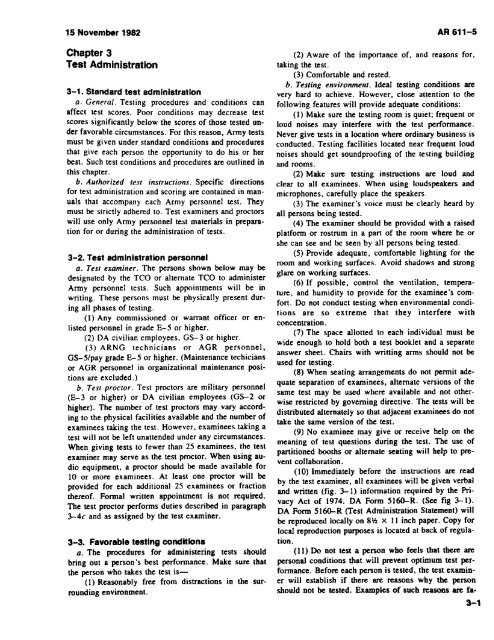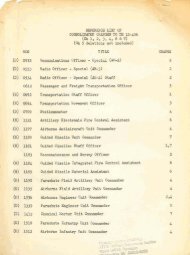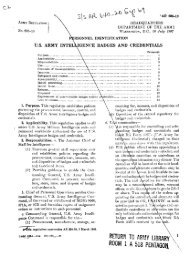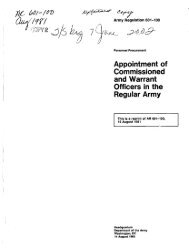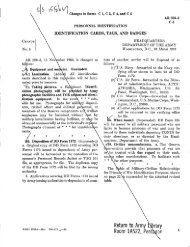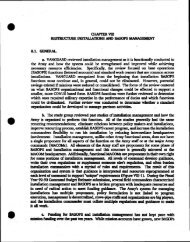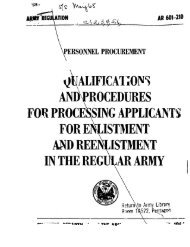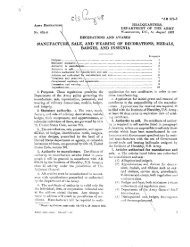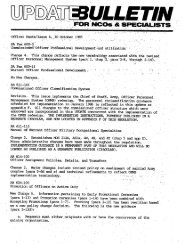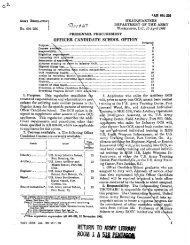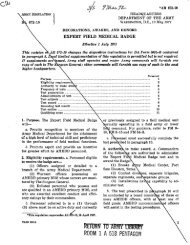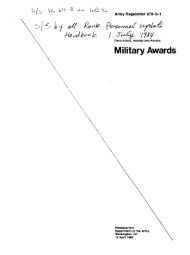Anny Personnel Selection and Classification Testing - Washington ...
Anny Personnel Selection and Classification Testing - Washington ...
Anny Personnel Selection and Classification Testing - Washington ...
Create successful ePaper yourself
Turn your PDF publications into a flip-book with our unique Google optimized e-Paper software.
15 November 1982Chapter 3Test Administration3-1. St<strong>and</strong>ard test administrationa. General. <strong>Testing</strong> procedures <strong>and</strong> conditions canaffect test scores. Poor conditions may decrease testscores significantly below the scores of those tested underfavorable circumstances. For this reason, Army testsmust be given under st<strong>and</strong>ard condilions <strong>and</strong> proceduresthat give each person the opportunity to do his or herbeSI. Such test conditions <strong>and</strong> procedures are outlined inthis chapter.b. Authorized lest instructions. Specific directionsfor test administration <strong>and</strong> scoring are contained in manualsIhat accompany each Army personnel tesl. Theymust be strictly adhered to. Test e..miners <strong>and</strong> proctorswill use only Army personnel test materials in preparationfor or during the administration of tests.3-2. Test administration personnela. Test eUlminer. The persons shown below may bedesignated by the TCO or alternate TCO to administerArmy personnel lests. Such appointments will be inwriting. These persons must be physically present duringall phases of testing.(I) Any commissioned or warrant officer or enlistedpersonnel in grade E-5 or higher.(2) DA civilian employees, GS- 3 or higher.(3) ARNG technicians or AGR personnel,GS-5/pay grade E-5 or higher. (Maintenance techiciansor AGR personnel in organizational maintenance positionsare excluded.)b. Test proctor. Test proctors are military personnel(E-3 or higher) or DA civilian employees (GS-2 orhigher). The number of test proctors may vary accordingto the physical facilities available <strong>and</strong> the number ofexaminees taking the test. However. examinees taking atest will not be left unattended under any circumstances.When giving tests to fewer than 25 examinees. the testexaminer may serve as the test proctor. When using audioequipment, a proctor should be made availab~e for10 or more examinees. At least one proctor wIll beprovided for each additional 25 examinees or fractionthereof. Formal written appointment is not required.The test proctor performs duties described in paragraph3-4c <strong>and</strong> as assigoed by the test examiner.3-3. Favorable testing conditionsa. The procedures for administering tests shouldbring out a person's best performance. Make sure thatthe person who takes the test is-(1) Reasonably free from distractions in the surroundingenvironment.AR 611-5(2) Aware of the imponance of. <strong>and</strong> reasons for,taking the test.(3) Comfortable <strong>and</strong> rested.b. Tesling environment. Ideal testing conditions arevery hard to achieve. However I close attention to thefollowing features will provide adequate conditions:(1) Make sure the testing room is quiet; frequent orloud noises may interfere with the lest performance.Never give tests in a location where ordinary business isconducted. <strong>Testing</strong> facilities located near frequent loudnoises should get soundproofing of the testing building<strong>and</strong> rooms.(2) Make sure testing instructions are loud <strong>and</strong>clear to all examinees. When using loudspeakers <strong>and</strong>microphones, carefully place the speakers.(3) The examiner's voice must be clearly heard byall persons heing tested.(4) The examiner should be provided with a raisedplatform or rostrum in a pan of the room where he orshe can see <strong>and</strong> be seen by all persons beiog tested.(5) Provide adequate, comfonable lighting for theroom <strong>and</strong> working surfaces. Avoid shadows <strong>and</strong> strongglare on working surfaces.(6) If possible, control the ventilation, temperalure,<strong>and</strong> humidity to provide for the examinee's comfon.Do not conduct testing when environmental conditions8re so extreme that they interfere withconcentration.(7) The space allotted to each individual must bewide enough to hold both a test booklel <strong>and</strong> a separateanswer sheel. Chairs with wrining arms should not beused for testing.(8) When seating arrangements do not permit adequateseparation of examinees, alternate versions of thesame test may be used where available <strong>and</strong> not otherwiserestricted by governing directive. The tests will bedistributed alternately so that adjacenl examinees do nottake the same version of the tesl.(9) No examinee may give or receive help on themeaning of test questions during the tesl. The use ofpartitioned booths or alternate seating will help to preventcollaboration.(10) Immediately before the instructions are readby the test examiner, all examinees will be given verb~1<strong>and</strong> wrincn (fig. 3-1) information required by the PrivacyAct of 1974, DA Form 51(j(}...R. (See fig 3-1,>_DA Form 51(j(}...R (Test Administration Statement) WIllhe reproduced locally on 8'1.z x 11 inch paper. Copy forlocal reproduction purposes is located at back of regulation.(II) Do not test a person wbo feels that there arepersonal conditions that will prevent optimum test performance.Before each person is tested, the test examinerwill establish if there are reasons why the personshould not be tested, Examples of such reasons are fa-3-1


